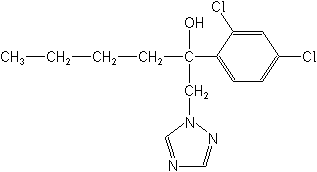Products >> Fungicides >> Hexaconazole
Hexaconazole
Hexaconazole 95%TC
Hexaconazole 5%SC
Fungicide
FRAC 3; DMI: triazole

NOMENCLATURE
Common name hexaconazole (BSI, ANSI, draft E-ISO, (m) draft F-ISO)
IUPAC name (RS)-2-(2,4-dichlorophenyl)-1-(1H-1,2,4-triazol-1-yl)hexan-2-ol
Chemical Abstracts name (?-a-butyl-a-(2,4-dichlorophenyl)-1H-1,2,4-triazole-1-ethanol
CAS RN [79983-71-4] Development codes PP523; ICIA0523 (both ICI)
Hexaconazole APPLICATIONS
Biochemistry Inhibits ergosterol biosynthesis (steroid demethylation
inhibitor). Mode of action Systemic fungicide with protective and
curative action. Uses Control of many fungi, particularly Ascomycetes
and Basidiomycetes, e.g. Podosphaera leucotricha and Venturia inaequalis
on apples, Guignardia bidwellii and Uncinula necator on vines, Hemileia
vastatrix on coffee, and Cercospora spp. on peanuts, at 15-250 g/ha.
Also used on bananas, cucurbits, peppers and other crops. Phytotoxicity
Non-phytotoxic when used as directed. Some injury noted on McIntosh
apples. Formulation types OL; SC; SG. Selected tradenames: 'Anvil'
(fruit) (Syngenta); 'Planete' (cereals) (Syngenta); 'Contaf' (Rallis);
mixtures: 'Columbia' (+ fenpropidin) (Syngenta)
Hexaconazole OTHER TRADENAMES
'Proseed' (Syngenta); 'Bullet 5' (Agro Chemicals); 'Canvil' (Vapco)
mixtures: 'Lynx' (+ chlorothalonil) (Syngenta); 'Sirius' (+ chlorothalonil)
(Syngenta) Discontinued names mixtures: 'Halley' * (+ ethirimol)
(Zeneca)
Hexaconazole ANALYSIS
Product by gc and FID. Residues by gc with either NPD, thermionic
or ECD detection. See K. J. Harradine et al., in Comp. Anal. Profiles,
Chapt. 2.
MAMMALIAN TOXICOLOGY
Reviews FAO/WHO 59, 61 (see part 2 of the Bibliography). Oral Acute
oral LD50 for male rats 2189, female rats 6071 mg/kg. Skin and eye
Acute percutaneous LD50 for rats >2000 mg/kg. Mild irritant to
eyes; non-irritating to skin (rabbits). Moderate skin sensitiser
(guinea pigs). Inhalation LC50 (4 h) for rats >5.9 mg/l. NOEL
(90 d) for rats 5, rabbits 50 mg/kg daily. ADI (JMPR) 0.005 mg/kg
b.w. [1990]. Other Non-mutagenic. Toxicity class WHO (a.i.) III
(Table 5); EPA (formulation) IV EC hazard Xi; R43| N; R51, R53
ECOTOXICOLOGY
Birds Acute oral LD50 for mallard ducks >4000 mg/kg. Fish LC50
(96 h) for rainbow trout 3.4, mirror carp 5.94, sheepshead minnow
5.4 mg/l. Daphnia LC50 (48 h) 2.9 mg/l. Bees Acute oral and contact
LD50 for honeybees >0.1 mg/bee. Worms LC50 (14 d) 414 mg/kg.
Hexaconazole ENVIRONMENTAL FATE
Animals Readily excreted by mammals, with no significant retention
in organs or tissues. Plants For details of the metabolism of hexaconazole
in cereals, see M. W. Skidmore et al., Br. Crop Prot. Conf. - Pests
Dis., 1990, 3, 1035-1040. Soil/Environment Rapidly degraded in soils
in laboratory tests.